What is Reynolds Number? Let’s study a very interesting parameter that is used in determining the type of flow of fluid which in turn gives us the data on whether the fluid will affect our object of study or not. This is an important parameter that helps in predicting the pattern of fluid flow in different situations and environments. Reynolds number equation, formula etc. has been well captured in this article.
What is Reynolds Number? Definition
Reynolds Numbers Basics
The dimensionless Reynolds number is important in predicting trends in fluid behavior. The Reynolds number, abbreviated as Re, determines whether the fluid flow is laminar or turbulent. Let’s consider a pipe where a fluid is flowing through it and a connection has been done with a separate line from where dye or ink is provided.
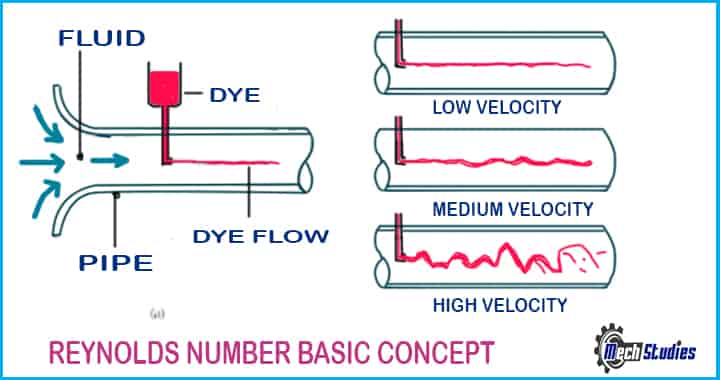
Now, we will observe a few things,
- If fluid velocity is less, then the dye or ink will be almost straight,
- If we increase the fluid velocity, the dye will start to fluctuate,
- Further increase the velocity, dye will highly fluctuate and mixed immediately with the fluid,
Why does the dye act differently with fluid? Let’s try to understand that flow characteristic depends on the flowings,
- Properties of fluid-like viscosity, density
- Velocity of fluid
- Dimension/diameter of pipe
Now, if velocity is increased, momentum (mass x velocity) will be increased, that is the inertial force and the same will be increased and simultaneously viscous force will also be changed. Here comes, Reynolds number is introduced to specify the relationship between inertial force and viscous force. It is one of the most important governing parameters in all viscous flows in which a numerical model is chosen based on a pre-calculated Reynolds number.
Reynolds Number Definition
The ratio of inertial forces to viscous forces inside a fluid exposed to relative internal movement owing to varying fluid velocities is known as the Reynolds number. This ratio distinguishes laminar flows from turbulent flows.
- A boundary layer, such as the bounding surface in the inside of a pipe, is an area where these forces change behavior.
- Although the Reynolds number includes both static and kinetic fluid characteristics, it is described as a flow parameter since dynamic situations are studied.
- Inertial forces oppose changes in an object’s velocity and are the reason for fluid flow.
- In turbulent flows, these forces are dominating in nature. Otherwise, the flow is laminar if viscous forces, defined as resistance to flow, are dominating.
What is meant by Reynolds Number?
Reynolds number means simply the ratio of inertial force to the viscous force and it can be expressed mathematically as given below:
- Re = Inertial Force / Viscous Force
- Re = FInertial/FViscous
Where,
- Re = Reynolds Number
- FInertial = Inertial Force
- FViscous = Viscous Force
History of Reynolds Number
British engineer and physicist, Osborne Reynolds proved that the fluid transition from laminar to turbulent flow in a pipe is the factor of few parameters and that value depends on
- the average velocity
- diameter of the pipe
- the mass density of the fluid
- absolute viscosity
He first showed the relationship between all the above parameters and the same theory is named as Reynolds Number based on his name.
Equation or Formula of Reynolds Number & Units
Reynolds Number Equation or Formula
Reynolds number determines whether a fluid flow will be laminar or turbulent by taking into account numerous parameters such as velocity, length, viscosity, and flow type. It is defined as the ratio of inertial forces to viscous forces and may be stated in terms of units and parameters, as shown below:
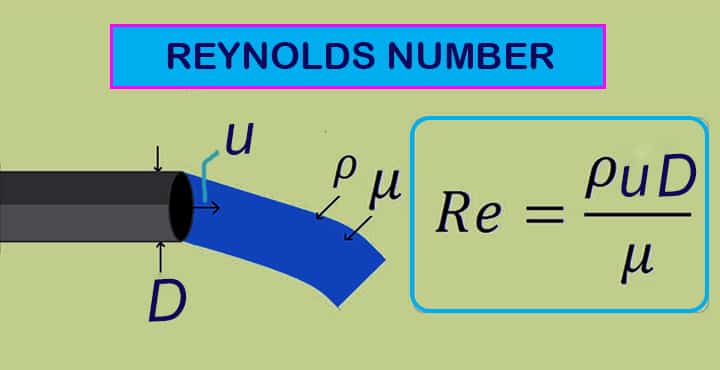
From the definition of Reynolds Numbers, Re = Inertial force / Viscous force
- Re = Momentum / Viscour force
- Re = Mass x Velocity / Viscous force
- Re = Density x Density x Velocity / Viscous Force
- Re = ρuD/μ = uD/ν [as ν = μ/ρ]
Where,
- ρ: is the density of flowing fluid in (kg/m3)
- u: is the velocity of fluid flow in (m/s)
- D: is the length through which the fluid flow in (m)
- μ: is the dynamic viscosity of the flowing fluid in Pascal – seconds or N-s/m2 or kg/m.s
- ν: is the kinematic viscosity in (m2/s)
The relationship between dynamic and kinematic viscosity is given by: ν = μ/ρ
Reynolds Number Units
From the formula of Reynolds Number, we can write, Re = ρuD/μ
Now, let’s try to find out the units of Reynolds number!
Unit of Reynolds Number = units of ρ x unit of u x unit of D / unit of μ
In S.I Unit,
- Unit of Reynolds Number = (kg/m3) x (m/s) x m / (kg/m.s)
- Unit of Reynolds Number = kg x m x m x m.s/(m3 x s x kg)
- Unit of Reynolds Number = 1 = no unit
Hence, we can say that the Reynolds number is a unitless property.
Reynolds Number Fluid Flow in Pipe (Closed Channel)
When fluid is flowing through a pipe there is a difference in the pattern of fluid flow, it can be smooth that is laminar or filled with eddies that are turbulent this can be defined in Reynolds number format as follows:
- Re = uDH/ν
- Re = ρuDH/μ
- Re = ρQDH/μA [as u = Q/A]
- Re = WDH/μA
Where,
- DH is the hydraulic diameter – it is generally taken for non-circular pipes.
- Q is the fluid’s volumetric flow rate measured in m3/s
- A is the cross-sectional area of the pipe in m2
- u is the mean velocity of flowing fluid
- μ is the dynamic viscosity of fluid measured in N·s/m2
- ν is the kinematic viscosity in m2/s
- ρ is the density of the fluid flowing through a pipe in kg/m3
The hydraulic diameter, DH, is assumed to be the typical size for internal-flow circumstances for forms such as squares, rectangular, or circular ducts when the height and width are equivalent.
DH =4A/P
- Where A represents the cross-sectional area and
- P represents the wetted perimeter. The entire perimeter of all channel walls in contact with the flow is the wetted perimeter of a channel. This means that the wetted perimeter does not include the length of the channel that is exposed to air.
In case of a circular pipe, the inside pipe diameter is equal to the hydraulic diameter
DH = D
- The Reynolds number’s application varies based on fluid flow characteristics such as density variation (compressibility), viscosity fluctuation (Non-Newtonian), internal or exterior flow, and so on.
- The crucial Reynolds number is an expression of the value used to define the transition between zones, which varies depending on the kind of flow and shape.
- While the essential Reynolds number for turbulent flow in a pipe is 2000, the critical Reynolds number for turbulent flow over a flat plate when the flow velocity equals the free-stream velocity ranges between 105 and 106.
- In the case of Newtonian fluids, the Reynolds number also predicts the viscous behavior of the flow. As a result, it is critical to comprehend the physical scenario in order to prevent making incorrect predictions.
- Newtonian fluids are those with constant viscosity. It makes no difference how much stress is applied to a Newtonian fluid if the temperature remains constant; it will always have the same viscosity. Water, alcohol, and mineral oil are a few examples.
Reynolds Number for Laminar and Turbulent Flow
Depending on the velocity and viscosity of the fluid, laminar flow or turbulent flow may occur when a fluid flows through a pipe or in between two flat plates or simply we can say within a closed channel. Laminar flow occurs at lower speeds, below a critical velocity above which the flow turns turbulent.
Reynolds Number for Laminar Flow
Laminar flow is defined in fluid dynamics as fluid particles following smooth courses in layers, with each layer passing smoothly through the subsequent layers with little or no mixing.
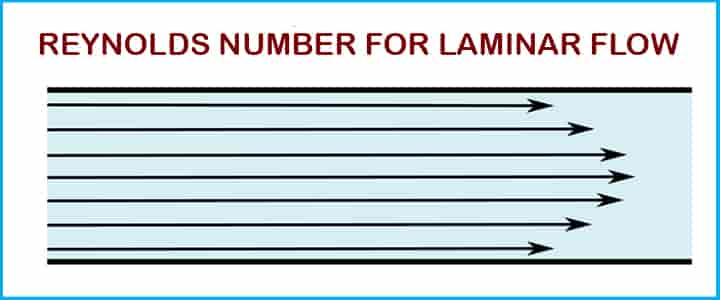
The fluid tends to flow without lateral mixing at low velocities, and neighboring layers slip past one another.
- There are no cross-currents perpendicular to the flow direction, nor are there any eddies or swirls of fluid.
- The motion of the fluid particles in laminar flow is exceedingly ordered, with particles near to a solid surface traveling in straight lines parallel to that surface.
- Laminar flow is more common when the fluid is flowing slowly or is highly viscous.
- The flow transition happens at a specific range of Reynolds numbers, which means when the flow will be transformed from laminar to turbulent, its Re will be specific.
- This range depends on the imperfections in the flowing system or small disturbance levels present in the fluid, as the Reynolds number increases, such as by increasing the flow rate of the fluid.
- If the Reynolds number is minimal, considerably less than one, the fluid will display Stokes, or creeping, flow, in which the fluid’s viscous forces dominate the inertial forces.
- Other definitions of Reynolds numbers can be used to anticipate the kind of flow around an item in fluid systems that occur on exterior surfaces, such as flow past objects hanging in the fluid or an aerofoil of the aircraft. For particles suspended in moving fluids, for example, the particle Reynolds number Rep would be employed.
- Laminar flow, like pipe flow, occurs at lower Reynolds numbers, whereas turbulent flow and associated phenomena, such as vortex shedding, occur at higher Reynolds numbers.
- The transition range of the Reynolds number is between 1800 – 2100 beyond which the fluid flow will turn into turbulent flow.
- Re < 2100 is considered as Laminar flow.
Reynolds Number for Turbulent Flow
Turbulent flow, also known as turbulence, is a kind of fluid motion characterized by unpredictable variations in pressure and flow velocity. It differs from laminar flow, which happens when a fluid flows in parallel layers with no interruption between them.
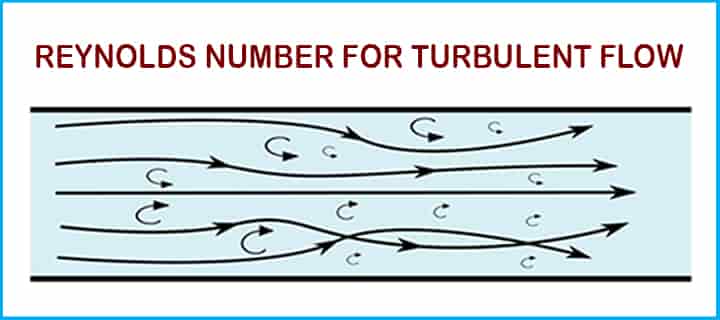
- Turbulent flow may be seen in daily phenomena such as waves, swiftly moving rivers, billowing storm clouds, or smoke from a chimney, and most fluid flows that occur in nature or are manufactured in industrial applications are turbulent.
- Turbulence is created by an excess of kinetic energy in a fluid flow, which exceeds the damping effect of the fluid’s viscosity. As a result, turbulence is typically observed in low viscosity fluids as opposed to laminar flow which occurs in highly viscous fluids.
- Turbulent fluxes are inherently extremely erratic. As a result, turbulence problems are often handled statistically rather than deterministically.
- The easily accessible source of energy in turbulent flows leads to expediting fluid mixture homogenization (mixing).
- The property responsible for greater mixing and greater rates of mass, momentum, and energy transfers in a flow is known as diffusivity.
- Turbulent flows feature non-zero vortices and are distinguished by vortex stretching, a powerful three-dimensional vortex generating process.
- In fluid dynamics, they are basically vortices exposed to stretching, which results in an increase in the component of vortices in the stretching direction owing to angular momentum conservation.
- The turbulent energy flow, on the other hand, relies on vortex stretching to develop and sustain recognizable structural functions.
- Turbulent flow is always three-dimensional and rotating. For example, atmospheric cyclones are rotating, but their two-dimensional structures prevent vortex production and hence are not turbulent.
- Oceanic flows, on the other hand, are inhomogeneous but basically non-rotational, and hence not turbulent.
- As turbulence dissipates fast when kinetic energy is transformed into internal energy by viscous shear stress, a consistent source of energy supply is necessary to sustain turbulent flow.
- Turbulence induces the production of eddies with a wide range of length scales. The large-scale structures hold the majority of the kinetic energy of turbulent motion.
- Re > 4000 is considered as Turbulent flow.
Reynolds Number for an Open Channel
Fluid flow having a free surface open to the atmosphere is referred to as open channel flow. Streams, rivers, and conduits are just a few examples. Open channel flow presumes that the pressure at the surface is constant and that the hydraulic grade line is located at the fluid’s surface.
- The hydraulic radius must be established for the flow of a liquid with a free surface. This is the channel’s cross-sectional area divided by the wetted perimeter.
- The hydraulic radius of a rectangular channel is the cross-sectional area divided by the wetted perimeter.
- Some texts then use a characteristic dimension four times the hydraulic radius, chosen because it gives the same value of Re for the onset of turbulence as pipe flow, whereas others use the hydraulic radius as the characteristic length-scale, resulting in different values of Re for transition and turbulent flow.
Reynolds Number for a Flying Object
Just like fluid flows in a pipe or an open channel, we have air as a fluid flowing abundantly with varied pressure in the atmosphere. This air obstructs the path of a flying object such that the object needs to shear through the fluid to fly smoothly.
- Let’s take an example of a plane, When you go flying, you want your plane to glide through the air easily. The air should flow over the wing and fuselage surfaces with as little disruption as possible.
- While air is not as dense as water, it does have some density. As a result, the air is hesitant to move aside to allow your plane to pass. Thus, with your airplane, as with the row boat, you must contend with two crucial characteristics: density and viscosity.
- The resistance encountered by a wing in flight is proportional to the Reynolds Number. Usually, the Reynolds Number is the deciding element in airflow, determining whether the inertial or viscous effect prevails. Let’s look at what the Reynolds Number values tell us about airflow and drag in general:
- The viscosity impact is low when the Reynolds Number is high. Inertia or density forces dominate for practical values, and parasite drag grows with the square of the velocity. However, even if the viscosity is minimal, it may still impact the very thin boundary layer, resulting in a turbulent flow.
- Thus, the Reynolds Number is important since it tells us what kind of flow we might expect. It tells you if you may expect laminar flow over your airplane’s wing and other sections. A low Reynolds Number results in laminar flow, whereas a high Reynolds Number results in a turbulent flow. Increasing the Reynolds Number reduces skin friction drag in both a laminar and a turbulent boundary layer. A turbulent layer, on the other hand, always has higher skin friction drag due to the increased energy loss in the boundary layer.
- Reynolds numbers are critical in airfoil design to control the “scaling effect” while computing and comparing properties, among other parameters.
Reynolds number for airfoil is given as follows:
R = Vc/ν
Where,
- R = Reynolds number
- V = Flying speed of the aircraft
- c = Airfoil’s chord length in m
- ν = Kinematic viscosity of a fluid in which the airfoil operates
Reynolds Number for an Object Immersed in a Fluid
In a viscous fluid, a moving item is comparable to a stationary item in a flowing fluid stream. The flow of a static fluid around a moving object might be laminar, turbulent, or a mixture of the two. It is possible to anticipate when a moving item causes turbulence, just as it is with the flow in pipes. For an object moving in a fluid, we use a different form of the Reynolds number N’R,
N’R = ρuD/ŋ
Where,
- N’R is the Reynolds number of an immersed object
- D is the characteristic length of an object (Can be diameter in case of the sphere)
- ρ is the density of the fluid
- ŋ is the viscosity of the fluid
- u is the speed of an object moving in the fluid
- If N’R is less than one, the flow around the object can be laminar, especially if the object is smooth. The transition to turbulent flow occurs for N’R values ranging from 1 to around 10, depending on surface roughness and other factors.
- Depending on the surface of the object, there may be a turbulent tail behind the item as well as some laminar flow across its surface.
- With an N’R between 10 and 106, the flow can be laminar or turbulent, or it can fluctuate between the two.
- In a case where N’R is greater than 106, the flow is completely turbulent even at the surface of the object.
- When the items in the fluid are tiny, such as raindrops, pollen, or blood cells in plasma, laminar flow occurs most of the time.
What are the Applications of the Reynolds Number?
The numerical solution of fluid flow is based on mathematical models developed via experimental research and associated principles of physics. One of the most important tasks in the numerical analysis is establishing a suitable mathematical model that reflects the physical world.
- The Reynolds number has been acknowledged as a significant necessity for fluid flow analysis in order to produce a fairly reasonable forecast of the behavior of fluids under diverse conditions.
- It is used to simulate the movement of objects moving in water or any other fluid.
- Atmospheric air is classified as a fluid. As a result, the Reynolds number may be computed for it. This enables it to be used in wind tunnel testing to investigate the aerodynamic characteristics of various surfaces.
- It is crucial in the testing of wind lift on aircraft and various airfoil shapes, particularly for supersonic flights when the high speed usually greater than Mach 1, It causes a localized rise in the density of the air around the aircraft.
- It is necessary to design a pumping as well as a piping system as well.
Reynolds Number Chart
Let’s see a simple chart of Reynolds numbers for reference. Refer below diagram or chart, commonly named as Moody chart to analysis the fluid flow.
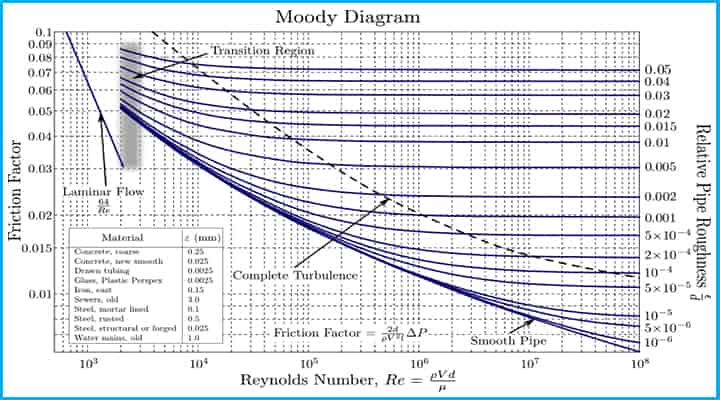
 via Wikimedia Commons
via Wikimedia Commons
Here, the relations of Reynolds numbers with friction factor, relative roughness are stated very clearly.
Reynolds Numbers range
Let’s see the value of Reynolds number of few common things,
| Sl. No. | Description | Reynolds Number |
| 1 | Bacterium | 1 × 10−4 |
| 2 | Fastest fish | 1 × 108 |
| 3 | Tuna swimming at 10m/s | 3× 107 |
| 4 | Smallest fish | 1 |
| 5 | Whale swimming at 10m/s | 3× 108 |
| 6 | Shark swimming | 8× 106 |
| 7 | Flapping wings of very small insects | 30 |
| 8 | Atmospheric tropical cyclone | 1 x 1012 |
| 9 | Blood flow in brain | 1 × 102 |
| 10 | A large ship | 5 x 109 |
| 11 | Blood flow in aorta | 1 × 103 |
| 12 | Duck flying at 20 m/s | 3 × 105 |
| 13 | Water droplet falling through air | 6.4 × 10−1 |
| 14 | Person Swimming | 4 × 106 |
| 15 | Wind blow at 10 m/s over wire | 1 × 103 |
Reynolds Number Calculation
Reynolds Number Question
A fluid is flowing at 3.0 m/s through a pipe of diameter 25 mm. Find out the Reynolds number. Also, determine the type of flow. Consider, the viscosity of that fluid is 0.45 Ns/m2 and 950 kg/m3 is the value of relative density.
Solution to Reynolds Number Question
Input Data given,
- u = Velocity of fluid = 3.0 m/s
- μ =Viscosity of fluid = 0.4Ns/m2
- ρ = Density of fluid = 950 kg/m2
- DH = Diameter = 20 mm = 20×10−3 m
From the Formula of Reynolds Number,
- Re = ρuDH/μ
- Re = 950 x 3.0 x 20 x 10-3 /0.4
- Re = 142.5
So, we have got the value of Reynolds number as 142.5. Now, we have already learned that if the value of Re is less than 2000, then the flow will be laminar. Hence, the flow will be laminar.
Conclusion
Over a century after its invention, the Reynolds numbers continue to play a significant role in the study of fluid mechanics and aerodynamics. It has several uses ranging from the design of fluid flow systems of closed and open channels to designing an airfoil based on its use characteristics and conditions of flying. It is a vital aspect of contemporary physics and the modern engineering world.

Excellent presentation, please add an example of calculating the Reynold’s number over a steel plate in shallow water